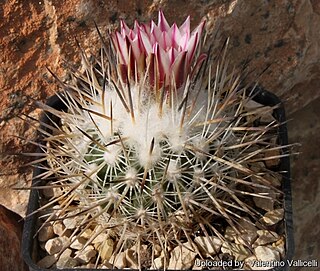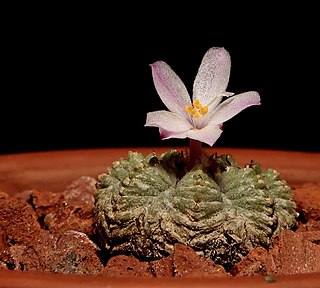
Geohintonia mexicana is a species of cacti, the only species in the genus Geohintonia. This genus is named after its discoverer George S. Hinton. As its specific epithet suggests, the plant is found in Mexico, where it grows on gypsum hills near Galeana.

Leuchtenbergia is a genus of cactus which has only one species, Leuchtenbergia principis. It is native to north-central Mexico. The genus is named after Maximilian Eugen Joseph (1817–1852), Duke of Leuchtenberg and amateur botanist.

Cochemiea macdougallii is a species of cactus in the genus Cochemiea.

Pelecyphora, pincushion cactus or foxtail cactus is a genus of cacti, comprising 20 species.They originate from Mexico and the United States.

Yungasocereus is a monotypic genus of cacti. Its sole species is Yungasocereus inquisivensis, native to Bolivia.

Yavia cryptocarpa is a species of cactus and the only species of the newly discovered genus Yavia. The genus is named after Argentina's department Yavi, Jujuy Province, where the plant is endemic to sparsely vegetated rocky slopes. The plant is also sometimes put in the tribe Notocacteae. The specific epithet cryptocarpa refers to the plant being a cryptocarp. This means that the fruits are formed inside the plant's body, thus being only visible when the plant shrinks in the drought period.

Ariocarpus agavoides is a species of cactus. It is endemic to Mexico. It grows in dry shrubland in rocky calcareous substrates. Some taxonomists place it in a separate genus as Neogomezia agavoides. The locals use the slime from the roots of the plants as glue to repair pottery. The sweet-tasting warts are eaten and often added to salads

Rapicactus mandragora, synonym Turbinicarpus mandragora, is a species of plant in the family Cactaceae.

Uebelmannia gummifera is a species of plant in the family Cactaceae. It is endemic to Brazil. Its natural habitat is dry savanna. It is threatened by habitat loss.

Aztekium ritteri is a species of cactus native to the Mexican state of Nuevo León.

Cleistocactus tominensis is a species of columnar cactus in the genus Cleistocactus, endemic to Bolivia, where it is found in forests, on cliffs, and in inter-Andean valleys at altitudes of 900 to 2,200 meters.

Echinocereus nivosus is a species of cactus native to Mexico.

Acharagma aguirreanum is a critically endangered microendemic cactus. It has a range of about one square kilometer in the calcareous semi-desert of the Sierra de la Paila in Coahuila, Mexico. Its population is estimated at less than 1000 individuals. Its only major threat is illegal collecting.

Oreocereus trollii, commonly known as the Old Man of the Andes cactus, is a species of cacti native to Argentina and Bolivia. Though listed as Least Concern by the IUCN, the plant is collected extensively, and in some areas is threatened.

Aztekium hintonii, is a species of cactus in the genus Aztekium. It is the second species of Aztekium discovered by George Sebastián Hinton in 1991.

Acharagma roseanum is a succulent cactus native to a small area of mountains of southeastern Coahuila and Nuevo León, Mexico. It grows on rocky limestone hills and xerophytic shrubland. Its name is often misspelled as "Roseana".

Matucana weberbaueri is a species of Matucana found in Peru.

Haageocereus versicolor is a species of Haageocereus found in Peru.

Coryphantha erecta is a species of Coryphantha found in Mexico.

Pelecyphora aselliformis is a species of Pelecyphora found in Mexico.























